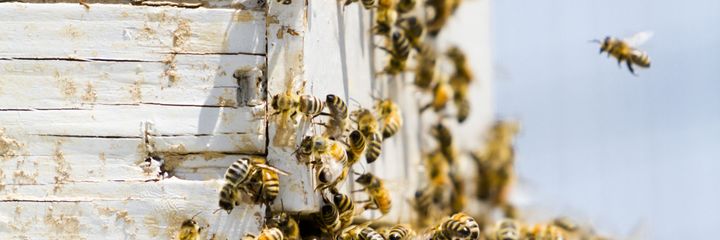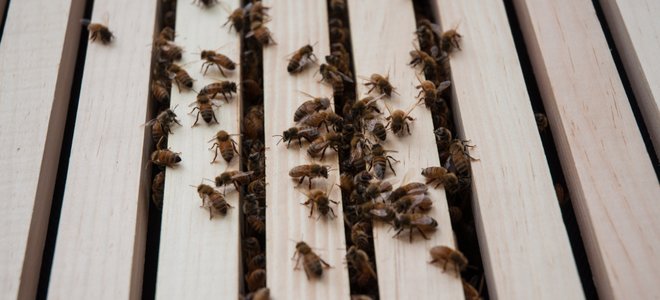
If you are tired of the constant buzzing, swarming, and stinging that come with living near a beehive or other bee habitat, then this article is for you. We will discuss how to get rid of bees in siding and keep them away from your home so that they don’t bother you anymore.
What is a beehive, and why do they swarm?
A beehive is a wax-based home built by bees. They are most often located in the walls, soffit or roofline of homes and buildings because it provides shelter from moisture, wind, predators and other environmental factors. When the weather gets warmer in the springtime, they will swarm to reproduce before winter – this is why the thousands often see them.
The most important thing to remember about bees is that their stinger is not barbed like a wasp’s, which means it will remain in your skin when they sting you. If you have ever been around someone who has had multiple bee stings, you may have noticed how swollen and irritated their skin gets. This is because the bee venom causes histamines to be released, damaging or destroying cells, tissue, and membranes in its path.
How to identify the location of the hive
If you are trying to identify the location of a hive, there are some key things to look for. First, do not disturb any bees or hives that you find – call an exterminator immediately! There is no sure-fire way how to get rid of bees in siding, but one thing’s for sure: it’s best if you don’t start a war with them.
Check for dark, oval-shaped spots in the siding or exterior wall of your homemade from a material darker than the surface around it, such as mud daubers’ nests, which are usually constructed from chewed-up plant matter and saliva to make soil cement. Sometimes their holes will be covered with bees trying to protect their home, so take extra caution if you see this.
Another good indicator is a large amount of sawdust-looking material near where the hive may be located or on surfaces such as patios, sidewalks, and decks close by. It’s not uncommon for them to make holes in shingles, soffits, or fascia boards to get into homes.
If you notice many bees around your home at night, it is likely because they are looking for a place to nest and aren’t trying to attack people. Bees only sting when provoked by swatting, spraying with water, making loud noises or vibrations from machinery such as lawnmowers.

How to Get Rid of Bees on Siding in a Natural Way
Most homeowners looking to get rid of bees in siding want the process to be as natural and environmentally friendly as possible. The best way for this is by using an organic pesticide that won’t harm you or your family, your plants, pets, or other wildlife.
One of the best ways to do this is with a product such as Eco Defense Organic Home Pest Control. It is a 100% natural and organic product that works by emitting powerful pheromones which confuse the bees’ sense of direction, causing them to become disoriented and eventually die from exposure.
Eco Defense uses no harsh chemicals or toxins, so it’s safe for use around children and pets. It is also non-staining so that it won’t discolor or harm your siding, plants, patio furniture, and more.
When sprayed onto the exterior of your home, it will stick to surfaces for up to 30 days, where bees can come into contact with it. The best part is that Eco Defense works on every type of bee – even Asian killer bees!
It’s also important to note that pesticides are only effective if applied directly or within proximity of a beehive. This is because bees will avoid coming into contact with harmful chemicals that could kill them, so using the proper pesticide close to their home or nesting area ensures they are exposed to it when trying to move around.
Closely monitor your property for bee activity and spray Eco Defense every 14 days during the Spring and Summer months where you live for best results. It’s the most accessible and most affordable way how to get rid of bees in siding!
Preventing future swarms from happening
The best way to prevent bees from swarming your home is by making it less appealing as a nesting location. If you have plant boxes, bird feeders, or food scraps around the exterior of your house, make sure they are not close to areas where the hive will be located.
Remove overhanging branches and trim them back, so they are at least 15 feet away from any entry points to your house. Also, try limiting the amount of mulch around the foundation as it makes an excellent place for bees to build their nests during Sprinhomeownersgtime when food is scarce.

When you should call an exterminator, if necessary
If you have a large bee infestation, don’t try to get rid of them yourself. Instead, call an exterminator that uses natural and organic methods that won’t pollute the environment or harm your family.
Just remember how important it is to keep children away from hives as they can be very dangerous if approached by people who are allergic to bee stings. If you see a swarm of bees in your yard, call an exterminator immediately and always avoid swatting or trying to spray them yourself, as this usually makes the problem worse!
